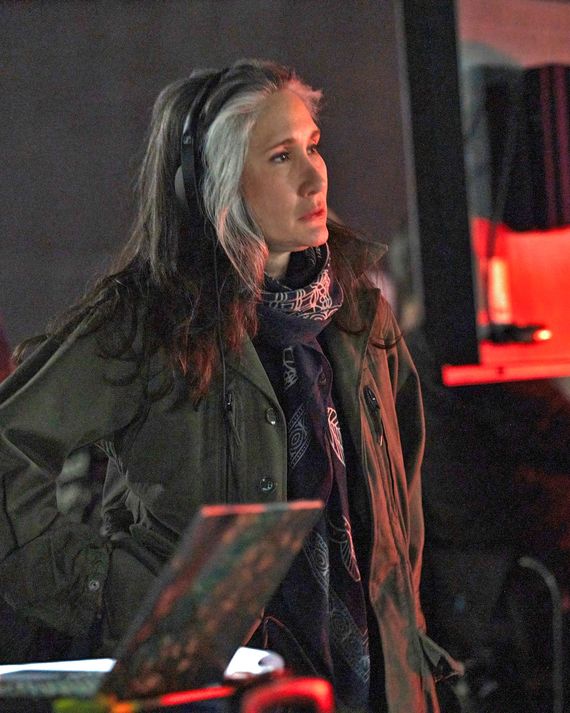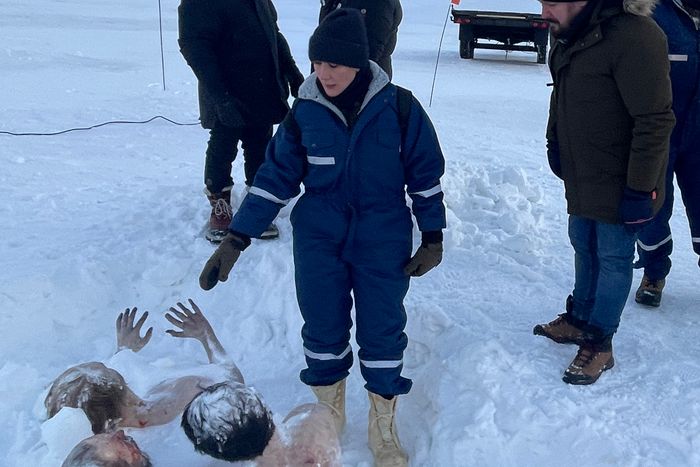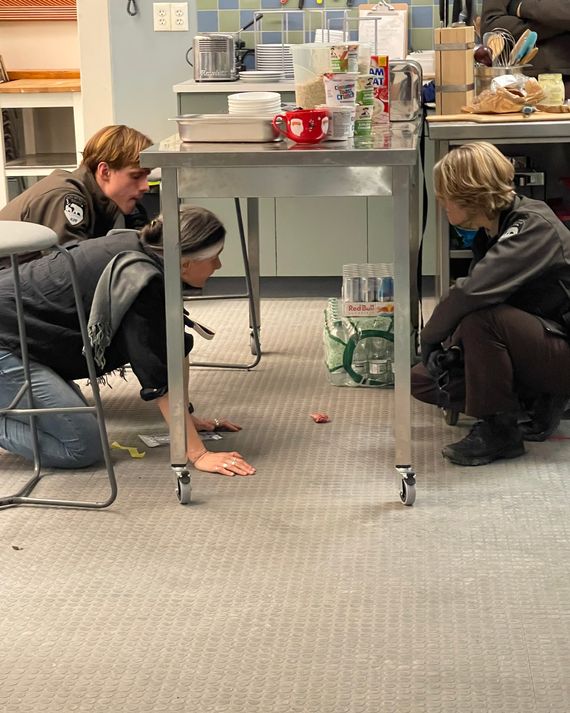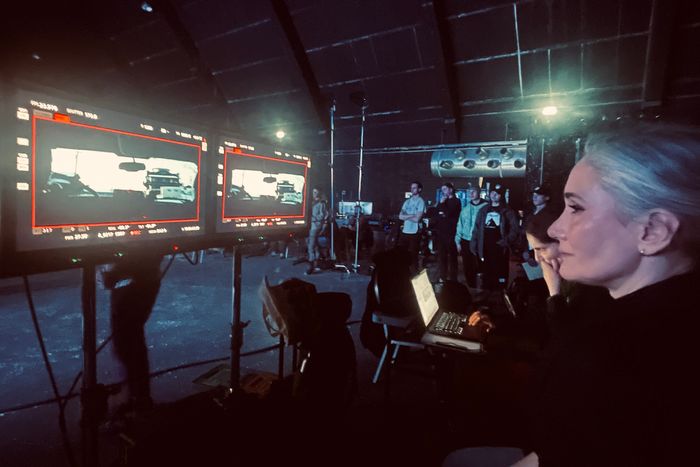
Spoilers follow for True Detective: Night Country finale “Part Six.”
There are three ways to read the ending of True Detective: Night Country, says showrunner Issa López. The real story: A group of Native women exacting revenge for the murder of Annie Kowtok sent the Tsalal scientists to their deaths on the ice. The fake story, a cover-up: The mining company secretly funding the research station and lining cops’ pockets blames a freak avalanche for the corpsicle. Both stories are narrative certainties in Night Country’s season finale, but the third reading, one in which a supernatural power — a ghost, a god, a force of nature, something else — met the scientists in their final moments is just as plausible: There’s an entity in Ennis we might not understand but some characters certainly feel. Ensuring the scripts had an ambiguity that allowed each viewer to decide just how realistic or fantastical they wanted Night Country to be was “my gift and my curse,” López explains. “To walk a tight line between genre and realism is my favorite hurdle to try to surpass,” she says. “My favorite option is a little bit of both.”
How do you write ambiguity? I’m assuming you’re not writing a story and then going back and saying, “Let’s put a ghost in here!”
I inhabit quite a divided psyche, and it has to do with my upbringing. I come from an agnostic, atheist father and a deeply Catholic mother, and both are gone from my life. But I do believe both walk with me. “No one ever really leaves” is my way of seeing things.
I don’t write and then look back on places to insert one or the other; as the story comes to me, the supernatural weaves itself in it. Interpretation is always in the point of view: What character is perceiving this reality, and what relationship does that character have with the supernatural? When Navarro hears voices, we know she comes from a long family history of mental-health issues and a sensitivity to the beyond. Is this really happening, or is this Navarro’s perception? Danvers is an absolute skeptic — but is she? When she’s thinking, she plays white noise to cut out other sounds. She has dreams where her dead son visits her. But are they dreams?
Season one did it. It’s hard to tell if it came from the writing or the directing, but it was definitely in the final mix, which is all that matters. Rust Cohle sees the spirals in the sky, sees little girls standing by the edge of the road, and at the very end stares into the depths of Carcosa and the universe and the beyond. Is this because he fried his brain with drugs when he was undercover? Or is it because he has learned to see beyond? That’s up to us to define. In this season, we can decide that these men walked onto the ice, the pressure dropped because there was a sudden blizzard, and their body temperature dropped so fast they developed delirium and died. Or, there was something in the dark. It’s for you to decide.
There are various nods and connections to the series mythology, like the spiral, which in the first season serves as a representation of Carcosa. In this season, Rose says it’s older than the ice. How did it speak to you as an image?
There’s no specific line of what the spiral means in season one. In season two, someone says it’s the symbol of a pedophile ring, but that is connected to the events of season one, where we see it ritualistically marked on the bodies of the victims and the places we imagine they’re performing rituals. According to the Cthulhu mythos and all the Lovecraftian lore, there is a kingdom beyond where the ancient gods roam. And that’s the part that I was like, Okay, this connects to what I’m doing. It’s not called Carcosa here; it has many different names. But Ennis is where the veil between our world and other worlds is becoming thin, where there is a connection to the place where the old gods roam.
When the hunter says in episode five, “Old hunters used to leave this as a warning of where the ice would swallow you,” that refers to how the cave system has a heart, the bone chamber. The creatures of the sea are the fossils that created that spiral: This is why Annie was having dreams about it, this place where she will die later. It all connects to the idea of repetition and the circles, a theme the first season has. It’s not necessarily that everything is connected, it’s just the same universe. Cohle’s father lived and died in Alaska, so if I have a ghost of an older man, it was an opportunity to say, This is the same world. The fact that they drink the same beer, little things like that create this feeling for people who love the first season.
Were there any specific Native or Indigenous mythologies that influenced “the woman who is now awake”?
I love the idea that the first season is a tremendously male season with a male mythology and the Yellow King. The other seasons are day and this is night, so this season naturally became female. And the night is female — we just know this. If the older gods are being awakened, what if we make her female? The damage that has been done to women and the environment — Mother Nature — would invite the idea of a wrath of a female god that we shouldn’t have been messing with.
I started to write, not giving her a name but thinking, Is Annie a manifestation of that god? As I was working, I obviously wondered, Maybe this connects with some sort of Inuit mythology. And lo and behold, when the Inuit producers came to the show, they analyzed the scripts and said, “Oh, this is Sedna. Let’s call her that,” and I was like, “If you give me your blessing, that’s fantastic.” But the more I worked on it and the more concrete I made it, the more it created conflicts with the way they saw it. I decided out of respect, that it was better to go back to my simpler suggestion. As happens with mythologies, there are many different versions of the story. In some of them, her fingers break because of the cold; in some of them, her father caused her fingers to break. Those little differences are massive. I stood back and said, “We’re going to leave it in the realm of suggestion. I don’t want to be disrespectful to something that is tremendously central to the identity of the Inuit.”
The season ends with the reveal that a group of Native and Indigenous women who worked as the research station’s cleaning staff were responsible for the scientists’ deaths as revenge for the killing of Annie K. You called these women the “Justice Ladies.” These actresses make such an impact. Some of them are also musicians, some of them are also activists. How did this group of women come together?
It was such a specific task. We read the hell out of them because they have to work individually and together. We had two fantastic consultant-producers in the show who became outright producers, Cathy Tagnak Rexford and Princess Daazhraii Johnson, who gave a lot of recommendations. Alaska casting directors Stacey Kane and Deborah Schildt went to Nome and the communities; Francine Maisler in Los Angeles was looking at Canada because when we’re talking Inuit, it doesn’t matter if they’re Canadian or Alaskan. Alda Gudjonsdottir and Julie Wieth were in Iceland, Greenland, and Denmark; a lot of the Greenlandic Inuit live in Denmark. And then there’s cases like Tanya Tagaq, who is an international rock star. She was one of the Justice Ladies and did additional music composing; her voice is all over the music and sound design of the series and now she’s a darling friend.
Many of them knew each other because of activism or music, but if they didn’t know each other, they were cousins with someone who knew them. They became really good friends: They were going out partying together, going swimming together and to the sauna in Iceland, and they were hungover together and then they came to set. [Laughs.] We invited them all for the premiere but we were like, “If you take photos together, don’t post them on social media until later, because it’s such a spoiler.” We couldn’t walk them on the red carpet, which broke my heart. We couldn’t bring attention to them. When I spoke at the premiere, the only people I thanked — because otherwise there’s so many names that I would get lost — were the Inuit people.
Kali Reis told me what a blast they were to be around. She said there were a couple times they were having too good of a time on set and you had to be like, “Please keep it quiet.”
Yes! We would be doing a different scene, and the cast for the next scene starts arriving, and I knew they were in the building even though we were in an isolated soundstage. I had to go and be like, “Ladies,” like a school teacher.
They were so passionate. The stunt coordinators were trying to train them with the guns they bring into the station, and many of these women who go hunting half the year were like, “This is not how you do it. You hold it like this.” They were terrifying when they came into the station in the best possible way. Before, I was like, “Ladies, we know why we’re doing this. This is a time of justice. We’re sick of this happening to and in our communities.” I was speaking to them as the characters, and then jokingly, I was like, “And think they are like your exes!” They were just laughing out loud. They came into the station and I was electrified. The scientists, who are trained actors and knew exactly what would happen, didn’t have to pretend. The women were a force. It was like a wave of power coming through the hallways in the station. It was beautiful.
You’ve said, “You write the impossible. You write what you want to see.” What felt impossible about Night Country? What did you want to make possible?
Shooting a whole TV series in the Arctic night, mostly in exteriors, seemed, not impossible, but certainly a challenge. It seemed kind of a crazy idea, to tell you the truth. You have to separate the filmmaker from the writer, and they will fight sometimes. The writer has to reign supreme when writing is happening and the director is probably going to be very mad at what the writer came up with. But you cannot let practicality or rationality get in the way of a fantastic story. You need to create the space as if no one had to shoot it later — certainly not you. [Laughs.]
You’ve said of True Detective, “the place is a character in itself.” Why Alaska?
It is the 49th state, but it stands far, far away from the rest of the United States. Nothing compares with the high Arctic and frozen ocean of northwest Alaska. It is a vast expanse with a very low population, so events take a long time to reach other communities. Secrets last longer and go deeper. Looking at the other seasons of True Detective and how they embrace the environment as a character, I was thinking, Maybe the desert is going to be different. But the second season has a really big and important set piece in the desert outside Los Angeles. That would have been a little bit easier to shoot, by the way, even though the desert is not kind. But when I thought of the ice and the absolute cold, it felt like a jolt of new energy into the franchise.
There’s an X-Files episode set in this area, there’s The Thing, there’s 30 Days of Night. We treat the ice and the snow like there’s so much waiting for us.
There is an elemental power to it, in the way the sea has it. If you go underwater, immediately, genre starts whispering: Captain Nemo, the James Cameron movie The Abyss. If you go into the depths of the Amazon jungle, the same thing will happen. It’s still perfumed with adventure and possibilities and the unknown. The ice holds secrets, and it’s ancestral; it’s been there for millions of years in the permafrost. If you dig, you’re going to find things that probably should stay asleep. When I put that together — the geography, the uniqueness, the separate-but-joined nature of Alaska with the rest of America, this immediate primordial mystical relationship we have with such spaces — it was a no-brainer.
You’re trying to convey the ancient feeling of this place. But you’re also telling a present-day story about the epidemic of missing and murdered Indigenous women.
I made a movie called Tigers Are Not Afraid and the inciting incident is the disappearance of a woman in Mexico, which is a horrendously common event. I took it to a festival in Edmonton and at least half the audience was Native, mostly Inuit. The moment the movie ended, they started to tell their stories about the women disappearing in their communities. That stayed with me. I thought, If there’s an occasion to talk about this in my work in English, I would. The moment I knew Night Country was going to be centered on the disappearance of a bunch of men, I felt there had to be this horrible continuity of the disappearance of Native women underneath, and how those two could and should be connected.
Navarro and Danvers often talk about those two central tensions in Ennis. The season really emphasizes how we see things and recognize they’re wrong but also accept that we can’t do anything about them.
In our daily lives, we find ourselves presented with these horrible conundrums, moral conundrums and existential conundrums, that we know are unacceptable. It happens in politics, the news, climate change, gender politics. Every day we have to negotiate the cognitive dissonance of, We cannot let another hour go by without stopping this! But I’m going to get a coffee and meet with my friends because there is nothing I can do at this moment except look away and continue living. And the series is a very respectful reminder that you actually can’t just go for coffee. [Laughs.]
Danvers loves telling people they’re not asking “the right question.” How did you land on that language?
You want your detectives to be brilliant, but they cannot be brilliant in the same manner that another 100 detectives have been brilliant. You have to create their own thing. Being a massive fan of Sherlock Holmes in my childhood and having seen every noir movie and detective show you can imagine, I had this challenge: What is the superpower of my detective? And man, it’s difficult. I knew Navarro’s was going to be a talent to communicate with people, a talent to understand the knitting of the community, and her gut instinct. But Danvers was hard. I didn’t want to do a wall with red string. So she puts every visual cue in front of her in a very orderly grid and starts making connections and creates chaos around her by mixing and mixing and mixing in order to find that little connection, this and this. That does a lot for the visual technique in the series.
“Ask the right question” was tough. I had a version of that scene on the stairs of the ice-skating rink with Prior where they were doing it with Legos. It was cute, but it didn’t speak to her deductive method. It was by rewriting and rewriting the scene that I found that very simple thing of, in order to find the right answer, you do have to ask the right question. Sometimes the gods of writing talk to you and I think I was simply asking the right question. And I got my answer.
Liz Danvers and Clarice Starling in The Silence of the Lambs are very different characters, but what I liked about the rink scene is that when Liz interacts with Prior, she is taking the Hannibal role to his Clarice, guiding him toward certain information. I love the mirroring of an iconic moment for Jodie but flipping it so she is in the position of authority.
I don’t know if it was conscious, but it’s definitely there. The thing about influences is even when you don’t know they’re there, they exist somewhere in your skull. It has happened several times in my work. The breaking of the arm and Lund waking up screaming is directly from Se7en, but I was not aware that it’s so obviously from Se7en until people started to make that connection when it aired. It happened in Tigers Are Not Afraid with the little girl drawing with the piece of chalk; I knew Pan’s Labyrinth was an influence, but I had edited the chalk piece out of my mind. When you’ve seen and consumed enough cinema, enough TV, enough novels, you’re not always aware of what you’re lifting from someone else’s work. Now they’re part of how you think. It’s an homage. Guillermo was never mad at me for the chalk. I hope Fincher doesn’t take it poorly. Jonathan Demme is no longer with us, sadly, but definitely that scene is Hannibal-Clarice moment. All of this comes from love.
This interview has been edited and condensed for clarity.
related
- The Best TV Valleys of 2024
- True Detective Crawls Back From the Void
- Night Country’s Kali Reis Claims Another Victory





